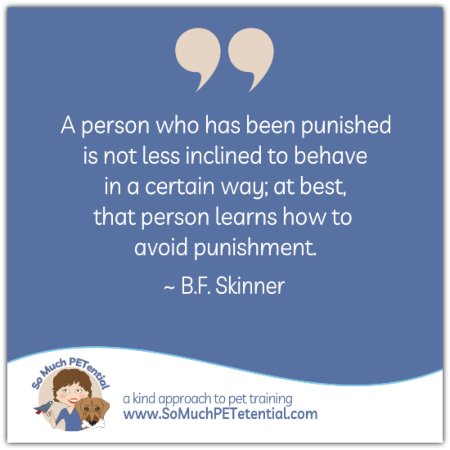I watched as a client’s puppy jumped and wiggled when she tried to clip a leash onto his collar.
“Is that the behavior you would like for him to exhibit each time you present a leash?,” I asked. “No,” was her answer.
I explained how, from her puppy’s standpoint, he is learning that his jumping behavior must be the cause for her to put his leash on since she clips the leash on immediately after he begins jumping. In other words, since his behavior was continuing, and even strengthening, we then know jumping is being positively reinforced by clipping on his leash. I then showed her how to teach him based upon consequences what behavior it was that she wanted him to do instead, which was sitting with his head still while the leash was clipped.
Here is the thing that is so important to remember about behavior. It NEVER occurs in a vacuum. Behavior is simply a tool that animals use to get consequences. They either use behavior to move toward something positive or to move away from something aversive. It is whatever happens immediately AFTER a behavior that influences the future rate of that behavior.
I thought I’d write about those consequences to give you a little more insight. There are four quadrants of consequences. They are Positive Reinforcement, Negative Reinforcement, Positive Punishment and Negative Punishment.
A good way to think about them is in this graphic.
So, what exactly does all this mean? I’ll explain.
Scientifically speaking Reinforcement is any consequence of a specific behavior that INCREASES and/or STRENGTHENS the future rate of that behavior. Punishment is any consequence of a specific behavior that DECREASES the future rate of that behavior.
People often think that reinforcement only refers to things like food or a toy, but reinforcement by definition simply means ANY consequence that causes a behavior to increase. On the flip side, punishment does not only refer to scolding, spraying with water, or spanking. Punishment is ANY consequence that reduces the probability of a behavior. It is important to note here that ONLY the animal that is doing the behaving chooses whether a consequence is a punisher or a reinforcer. Always, that value is from the eyes of the learner.
As some examples, if, after your bird screams, you yell back at it; and the bird continues to scream and even scream louder, THEN we know that your bird is being reinforced for screaming by you yelling back at it. If you reach down and pet your dog after it jumps on you, then your petting it is reinforcing its jumping. On the other hand, if you walk out of the room when your bird screams and your bird screams less in the future, then, from a scientific standpoint, your leaving the room is punishing your bird’s screaming behavior. Similarly, if your dog begins barking and pawing in his crate when you walk away; after which, you turn around to tell him quiet AND his behavior continues when you begin to walk away; then you know your turning back around and talking to him (attention) is reinforcing his pawing/barking.
Let’s break this down even further.
Reinforcement
Within Reinforcement, there is Positive (R+) and Negative (R-). R+ means something is added to the environment that is of value to that animal. To that animal being the key words. You may think you are giving your pet (or child or co-worker for that matter) positive reinforcement by giving it a treat or toy, but if the rate of that behavior is not increasing, then by definition it is not a reinforcer to that learner. (Please see my post on the difference between reward and reinforcement.) Let’s say for example, you are teaching your dog to come to you and when he gets there you give him a nice head rub while telling him he is a good boy. BUT he begins coming LESS to you when you call. Then, you are actually not reinforcing his recall behavior. In fact you are by definition punishing it. If, on the other hand, you give your dog a nice piece of meat or take out a favorite tug toy when your dog comes, and he comes MORE often and more quickly with a tail wagging, then you know you are giving an R+ consequence.
Looking at a scenario with a bird, if your bird begins to scream when you pick up the telephone; and the consequence is your putting the phone back down (which inevitably you will need to do eventually); and your bird screams MORE when you answer the phone, then we know that your bird is receiving R+ for screaming when you answer a call. (Note: Important to solving this behavior problem then is figuring out what that consequence is that is maintaining the behavior in that circumstance.)
R- on the other hand means something that the learner considers aversive is removed from the environment immediately following a behavior. If, after your dog growls at you, and you back away, then your dog is being reinforced negatively for growling and he will growl more when you approach him (probably at a specific time or circumstance). His growling worked to get something aversive, which was you, to back away. (Please read my post on what you should do if your dog growls.) If, an approaching stranger takes steps backward after a bird runs to the back of his cage; and that bird runs to the back of his cage more when someone it does not know comes close, then that bird’s behavior is being negatively reinforced.
Punishment
Positive Punishment (P+) refers to a consequence that is adding something to the environment that is aversive to the learner immediately after a behavior. If you jerk your dog’s leash or give him a shock using an E-collar when he pulls on a leash; and he pulls on the leash less in the future, then you are using P+.
If you wobble your hand when your bird (who is standing on it) puts his head down to nip at you, and your bird puts his head down less in the future, then you are also using P+. You have added something unpleasant to your pet’s environment.
Negative Punishment (P-) refers to a consequence that is removing something positive from the environment to decrease the probability of a behavior. When you turn your back and walk out of the room when your dog barks in his crate or your bird screams in his cage, if the barking and screaming behaviors decrease in the future, then you have used negative punishment (assuming that your dog and bird see value in your presence).
Learning and understanding this, you realize that using positive reinforcement 100% of the time would be difficult to do; however, I make the commitment to use the most positive and humane strategies possible to modify and manage behavior.
The Humane Hierarchy is a ranking of training methodologies going from least intrusive for the learner to most intrusive with Level 1 being the most socially acceptable and giving the animal the highest amount of control. How do you think those quadrants rank in terms of most positive to the learner? Please click here to find out and learn more about the Humane Hierarchy.






